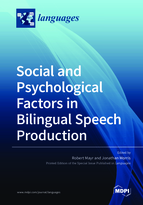Social and Psychological Factors in Bilingual Speech Production
A special issue of Languages (ISSN 2226-471X).
Deadline for manuscript submissions: closed (26 February 2021) | Viewed by 36420
Special Issue Editors
Interests: bilingual and multilingual speech development; L2 speech learning; L1 attrition of speech; acoustic and articulatory phonetics; phonetics and phonology of language contact; speech patterns of heritage language speakers and new speakers
Special Issue Information
Dear Colleagues,
We are currently inviting submissions for a Special Issue of Languages entitled “Social and Psychological Factors in Bilingual Speech Production.”
Studies in the fields of bilingualism and second language acquisition have shown that both cognitive and affective psychological factors can influence individuals’ bilingual speech production (e.g., Flege et al., 1999; Moyer, 2014; Piske et al., 2001). More recently, both experimental and variationist studies of bilingual communities have examined the role of social factors on bilinguals’ speech, particularly in cases of long-term language contact and minority-language bilingualism (e.g., McCarthy et al., 2013; Nance, 2015, 2019; Sharma & Sankaran, 2011). The Special Issue will bring together work on the psychological and/or social factors which influence bilingual speech production as well as work using different methodological frameworks. Our aim is to examine the role of such factors on bilingual speech production in diverse contexts, in order to provide a more holistic account of the ways in which extra-linguistic influences may affect bilinguals’ speech in one or both of their languages.
We invite submissions which examine the role of psychological and/or social factors on bilingual speech production. We interpret bilingualism in its broadest sense and the Special Issue will include work on bilingual first language acquisition as well as second language acquisition across speech contexts. Such contexts may include, but need not be limited to:
- heritage-language speakers
- minority-language bilinguals
- new speakers
- contexts of tutored and naturalistic second language acquisition
- instances of language attrition
We request that, prior to submitting a manuscript, interested authors initially submit a proposed title and an abstract of 400-600 words summarizing their intended contribution. Please send it to the guest editors ([email protected]; [email protected]) or to /Languages/ editorial office ([email protected]). Abstracts will be reviewed by the guest editors for the purposes of ensuring proper fit within the scope of the Special Issue. Full manuscripts will undergo double-blind peer-review.
The tentative completion schedule is as follows:
Deadline for abstract submission: 23 October 2020
Notification of abstract acceptance: 30 October 2020
Deadline for manuscript submission: 26 February 2021
References:
Flege, J. E., Yeni-Komshian, G. H., & Liu, S. (1999). Age constraints on second-language acquisition. Journal of Memory and Language, 41, 78-104.
McCarthy, K., Evans, B., & Mahon, M. (2013). Acquiring a second language in an immigrant community: The production of Sylheti and English stops and vowels by London-Bengali speakers. Journal of Phonetics, 41, 344–358.
Moyer, A. (2014). Exceptional outcomes in L2 phonology: The critical factors of learner engagement and self-regulation. Applied Linguistics, 35, 418-440.
Nance, C. (2019). Bilingual language exposure and the peer group: acquiring phonetics and phonology in Gaelic medium education. International Journal of Bilingualism, doi: 10.1177/1367006919826872
Nance, C. (2015). 'New' Scottish Gaelic speakers in Glasgow: A phonetic study of language revitalization. Language in Society, 44, 553-579.
Piske, T., MacKay, I. R. A. & Flege, J. E. (2001). Factors affecting degree of foreign accent in an L2: a review. Journal of Phonetics, 29, 191–215.
Sharma, D., & Sankaran, L. (2011). Cognitive and social forces in dialect shift: Gradual change in London Asian speech. Language Variation and Change, 23, 399–428.
Dr. Robert Mayr
Dr. Jonathan Morris
Guest Editors
Manuscript Submission Information
Manuscripts should be submitted online at www.mdpi.com by registering and logging in to this website. Once you are registered, click here to go to the submission form. Manuscripts can be submitted until the deadline. All submissions that pass pre-check are peer-reviewed. Accepted papers will be published continuously in the journal (as soon as accepted) and will be listed together on the special issue website. Research articles, review articles as well as short communications are invited. For planned papers, a title and short abstract (about 100 words) can be sent to the Editorial Office for announcement on this website.
Submitted manuscripts should not have been published previously, nor be under consideration for publication elsewhere (except conference proceedings papers). All manuscripts are thoroughly refereed through a double-blind peer-review process. A guide for authors and other relevant information for submission of manuscripts is available on the Instructions for Authors page. Languages is an international peer-reviewed open access monthly journal published by MDPI.
Please visit the Instructions for Authors page before submitting a manuscript. The Article Processing Charge (APC) for publication in this open access journal is 1400 CHF (Swiss Francs). Submitted papers should be well formatted and use good English. Authors may use MDPI's English editing service prior to publication or during author revisions.
Keywords
- bilingualism
- speech production
- acoustic and articulatory phonetics
- language contact
- socio-phonetic variation in bilingual communities
- L2 speech learning
- L1 and L2 attrition of speech
- heritage languages
- new speakers







